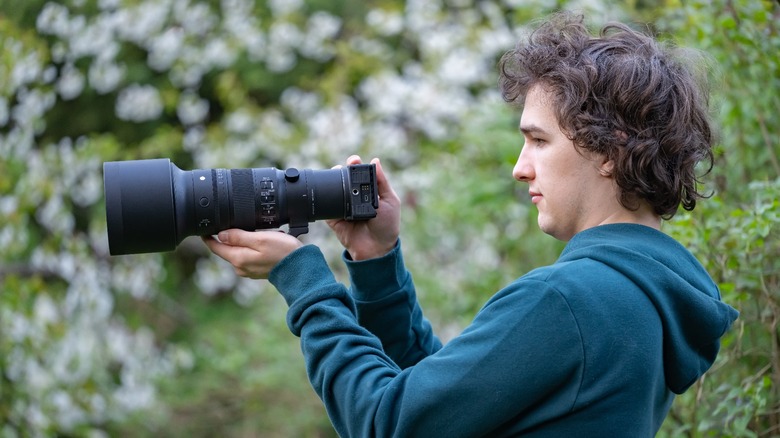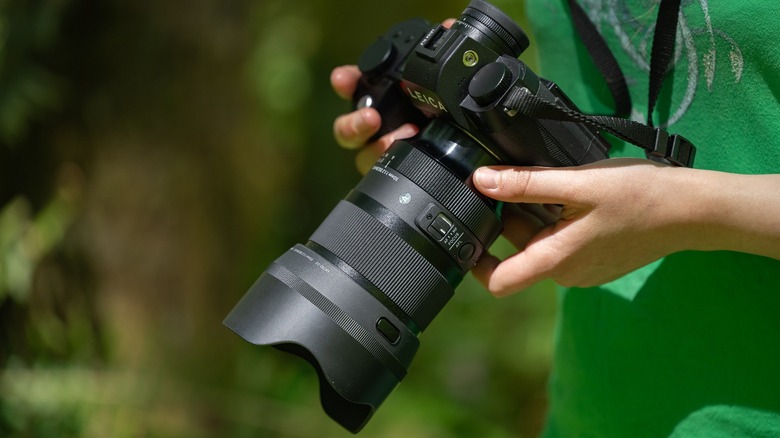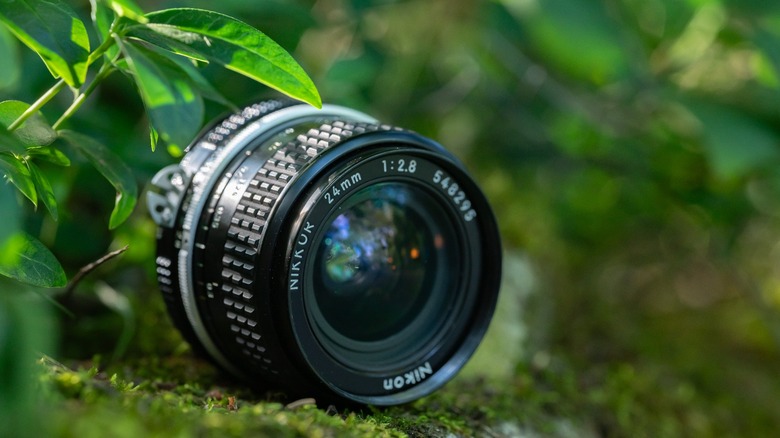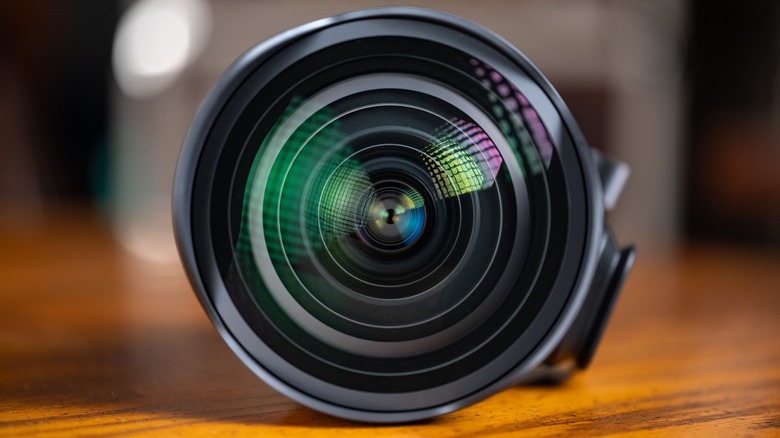What Are Prime Lenses, And Why Are They So Popular With Pro Photographers?
We may receive a commission on purchases made from links.
Most photographers will start out with zoom lenses, but the more serious you get about the hobby, the more likely you are to seek out solutions to specific scenarios, which is where prime lenses come in. A prime lens is essentially a lens which doesn't zoom. It has a fixed focal length, and you can identify a prime lens by the fact that it will only have one listed focal range.
For example, a zoom lens might be labeled as 24-70 millimeters, while a prime lens will only be a 24-millimeter, a 70-millimeter, or some other individual number. This individuality is what defines prime lenses; where zoom lenses are do-it-all jacks-of-all-trades, prime lenses are specialized tools with highly specialized purposes in mind.
As a professional photographer, I use prime lenses every day, and they are essential to my work. For me, it's chiefly prime macro lenses that do the heavy lifting in my work as a pro-photographer, capturing various products (often other cameras and lenses) in exquisite detail.
As much as I appreciate the useful range of zoom lenses, which play a vital role in my work as well, prime lenses often deliver the most eye-catching results.
Lighter than zoom lenses, but not necessarily any smaller
Prime lenses don't need to have as much glass or as many mechanical components as zoom lenses. This means they often represent significant savings in size and weight compared to their counterparts with variable focal ranges. For example, a Nikkor Z 100-400 millimeters f/4.5-5.6 VR S weighs a little over three pounds, while the Nikkor Z 400-millimeter f/4.5 VR S weighs just 2.5 pounds, despite having a significantly brighter aperture at 400 millimeters.
Interestingly, the weight advantage doesn't necessarily translate to a size advantage. Due to the immutable laws of physics, a lens of a certain focal range and aperture can only be shrunk so far. This is why, of the lenses used in the prior example, the 400-millimeter f/4.5 prime lens is slightly larger than the 100-400-millimeter f/4.5-5.6 due to the darker maximum aperture of the latter lens.
One of my favorite prime lenses is the Nikkor Z 800-millimeter f/6.3 VR S, which is spectacularly lightweight for its focal length and aperture. It's still a huge lens, but it's not so much of a burden that I can't haul it along on hiking trips when there's a high probability of spotting wildlife.
Better image quality
Thanks in part to their simplicity, prime lenses typically perform better than zoom lenses. A zoom lens needs to be tuned at its widest point, at its longest point, and at every point between. It's almost inevitable that a zoom lens' performance will vary widely throughout its focal range. Common deficiencies of zoom lenses include worse vignetting, chromatic aberration, flaring, and reduced sharpness, often at the extreme ends of their focal range. Zoom lenses will often have a sweet spot somewhere midway through their focal range.
Prime lenses, on the other hand, need only be fine-tuned to one focal length, and you can be sure that each has been fully optimized. This doesn't mean that every prime lens is perfect, but it's safe to assume that any prime lens is better than if it were just one stop in the focal range of a zoom lens. Very high-end zoom lenses can perform so well that they are almost as good as prime lenses, but quality also comes with tradeoffs.
Better value in some ways, worse in others
Prime lenses can offer more bang for your buck in some regards, though zoom lenses can do the job of several primes in one lens. A 50-millimeter f1.8 is almost always going to be a mere fraction of the price of a 20-70-millimeter f/2.8, despite being far brighter and capable of the same or better image quality.
With that said, value is very subjective here. While prime lenses have definite value advantages over zoom lenses, a good zoom lens provides a lot of flexibility – it means you need to change lenses less often. If you were to buy the 24, 28, 35, 40, 50, 55, and 70-millimeter prime lenses to cover the full range of a 24-70-millimeter lens, it would almost certainly cost you more than the zoom. You almost certainly don't need all those individual focal ranges in your kit at the same time.
For example, when using a zoom, I find myself frequently shooting at particular focal ranges within the zoom range. You can use software such as Adobe Lightroom to look back through your photos taken with zoom lenses to see what focal ranges you use the most, and that's probably a good indicator of what prime lens would best suit you. I find myself often shooting at 35 millimeters with my Nikkor Z 24-120-millimeter f/4 S lens, so I'm considering buying a 35-millimeter prime lens (I'm waiting for Nikon to launch the 35-millimeter f/1.2).
Primes can be more specialized for niche purposes
Zoom lenses are typically fairly straightforward, while prime lenses have greater latitude for experimentation with unique designs meant for niche purposes. A great example of this is macro lenses. I own a few of these myself, as they are perhaps the single most helpful type of lens to me professionally, as product photography is a big part of my work.
Many zoom lenses will advertise themselves as "macro" lenses but will typically only offer a magnification ratio of 1:2 at best. A true macro lens features a magnification ratio of at least 1:1, with some, such as the Laowa 100mm f/2.8 2X, offering a crazy 2:1 ratio that lets you get insanely close. Most of the photos you will see in my product review articles here on SlashGear were captured with the Nikkor Z MC 105-millimeter f/2.8 VR S.
Portrait lenses are almost invariably prime lenses, with 85 millimeters being particularly popular, while tilt-shift lenses allow the user to manipulate perspective. Super-telephoto prime lenses allow you to get up close to subjects you can't physically approach and often deliver bright apertures despite their long focal lengths. Ultra-wide lenses are great for capturing the Milky Way, with Sigma's 14-millimeter f/1.4 being a particular favorite of mine due to its extremely bright aperture.
What is bokeh and why prime lenses do it best
Bokeh refers to the quality of out-of-focus areas in your image, and typically, what you want is creamy, smooth bokeh with gradual transition areas. This shallow depth of field is a great way to separate your subject from the background or foreground and is extremely useful for removing distractions in complex environments.
Prime lenses often deliver better out-of-focus areas than zoom lenses, largely thanks to their typically extra-bright apertures. A zoom lens might have an aperture of f/4, f/5.6, or even higher. Even at wide and moderate focal lengths, a zoom lens typically won't have an aperture wider than f/2.8, with only a couple of zoom lenses from Sigma and Canon featuring f/1.8 and f/2, respectively.
With primes (aside from super telephoto lenses and those designed specifically for portability) f/2.8 is about as dark as they go, with f/1.8 and brighter being common. Some even go as bright as f/0.95, and if you're looking for maximum bokeh, a moderate telephoto lens with an extremely bright aperture is what you want. Additionally, these extremely bright apertures help immensely in low-light scenarios.
Building better photography habits
Zoom lenses can make photographers lazy, while prime lenses help to improve their skills. With a zoom lens, there's the temptation to stand in one place and not look for new compositions. You can get into the bad habit of taking the same photo from the same angle, just with slightly different focal ranges. With prime lenses, you've got to move around in what is frequently referred to as "zooming with your feet." In doing so, you change your perspective and find new compositions.
The aforementioned niche designs of many prime lenses further lend themselves to creativity. You're both more likely with prime lenses to select the right tool for a particular job, and in situations where you don't have quite the right lens, you're more likely to find unique compositions than if you had access to a jack-of-all-trades zoom. Zooms get the job done, but prime lenses can make you a better photographer.
The first prime lenses to add to your kit
Some prime lenses make more sense to buy before others, with the 50-millimeter f/1.8 being the obvious and most frequently recommended. Affectionately known as a "nifty fifty", 50-millimeter f/1.8 lenses are typically very affordable, and practically every system has at least one available. They're a good, cheap way of dipping your toes into the world of prime lenses that allows you to capture beautiful bokeh. With that said, I personally find wider or longer primes to be more useful and conducive to creativity.
I would highly recommend picking up a macro prime lens with at least 1:1 macro capability. They're useful in a lot of different scenarios in addition to macro work, and mine often see use as portrait lenses. If you don't mind going with a used lens, they can be found for really cheap, but new ones with manual focus are also relatively affordable, such as the Laowa 100-millimeter f/2.8 2X, which is only around $500 on Amazon.
An ultra-wide angle lens is also a good idea, and while my chief recommendation remains the Sigma 14-millimeter f/1.4, the Viltrox 16-millimeter f/1.8 has autofocus and a very bright aperture for less than $600. If you want to photograph wildlife, a super telephoto prime lens is also something you'll eventually want to pick up. I adore my Nikkor Z 800-millimeter f/6.3 VR S, and while it's quite pricey, I absolutely recommend it if you're using a Nikon Z8 or other Z mount camera and want to get into wildlife photography.
Don't disregard vintage prime lenses
Zoom lenses often don't hold up well over time, but vintage prime lenses frequently offer desirable qualities at bargain prices. I, myself, cannot resist them when I come across them at yard sales. Some vintage lenses are so well regarded that they demand huge prices on the used market. This is because by using vintage prime lenses you can achieve unique looks not offered by modern lenses, or just save a buck on older hardware that's still perfectly functional.
Be careful, though. I've certainly bought more than a few vintage primes that turned out to be duds. This past summer, I bought a really cool lens attached to a film camera, thinking I'd adapt it to my modern mirrorless camera, only to discover later that it was integrated into the camera. Also, be sure to examine the lenses for mold, and make sure the aperture dial is working. If something is semi-broken, you might be able to fix it, but many times I've confidently bought broken gear and only succeeded in breaking it further myself. However, if you instead shop from reputable second-hand retailers and not just random thrift stores and yard sales, you can mostly avoid such pitfalls.
Prime lenses you can only dream of owning
The most desirable and unobtainable lenses are almost always prime lenses. If you want the best of the best, then you'll have to pay, and in some cases that'll set you back more than a good used car. The Nikkor Z 50-millimeter f/0.95 Noct, for example, is an $8,000 chunk of glass that's completely nuts, but nonetheless, a lens that any photographer would love to own despite its impracticality.
Of course, super telephoto primes are also extremely pricey, and you can expect to pay as much as $20,000 for something like Canon's 1200-millimeter f/8 or $14,500 for the Nikkor Z 600-millimeter f/4 TC, so named for it's built-in 1.4 teleconverter, which allows this prime lens to zoom from 600 millimeters to 840 millimeters with the flick of a switch. That essentially makes it both a prime lens and a zoom lens, so you get the best of both worlds.
Then there's Nikon's famous 13-millimeter f/5.6, sometimes called the "Holy Grail" due to its astonishing lack of distortion. Only 350 were made, and when they do come on the market, they go for upwards of $50,000. There's a rabbit hole worth going down for such rare and expensive lenses, with the priciest ever sold being the Leica APO-Telyt-R 1600-millimeter, which cost around $2 million.




